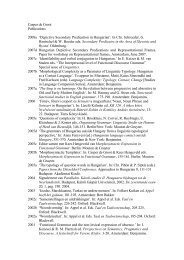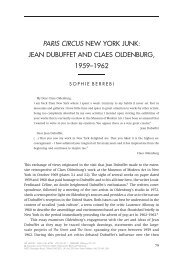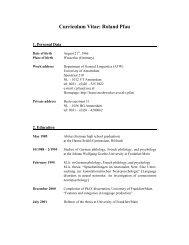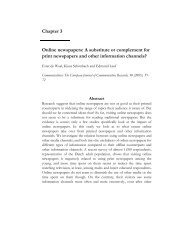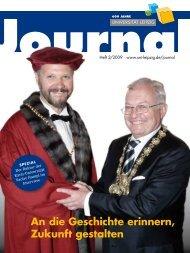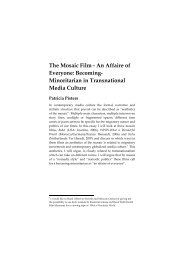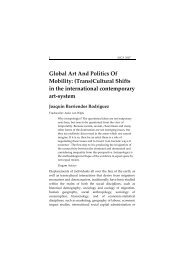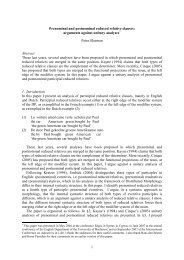Hyperdetermination in German Sign Language plurals
Hyperdetermination in German Sign Language plurals
Hyperdetermination in German Sign Language plurals
Create successful ePaper yourself
Turn your PDF publications into a flip-book with our unique Google optimized e-Paper software.
27. Jahrestagung der Deutschen Gesellschaft für Sprachwissenschaft (AG 6), Köln, 25.02.2005<br />
<strong>Hyperdeterm<strong>in</strong>ation</strong> <strong>in</strong> <strong>German</strong> <strong>Sign</strong> <strong>Language</strong> <strong>plurals</strong><br />
Roland Pfau (Uni Amsterdam) & Markus Ste<strong>in</strong>bach (Uni Ma<strong>in</strong>z)<br />
r.pfau@uva.nl ste<strong>in</strong>bac@.uni-ma<strong>in</strong>z.de<br />
1 Introduction: Under- and overdeterm<strong>in</strong>ed <strong>plurals</strong> <strong>in</strong> spoken language 1<br />
→ Morphological under- and overdeterm<strong>in</strong>ation is attested <strong>in</strong> many languages. Consider, for<br />
example, plural formation <strong>in</strong> <strong>German</strong> and English. On the one hand, the plural form can<br />
be expressed by zero mark<strong>in</strong>g as <strong>in</strong> (1). On the other hand, pluralization may also <strong>in</strong>volve<br />
double mark<strong>in</strong>g (i.e. stem change <strong>in</strong> comb<strong>in</strong>ation with affixation) as <strong>in</strong> (2).<br />
(1) a. Segel → Segel b. Fahr-er → Fahrer<br />
sail sail:PL drive-DS drive-DS:PL<br />
‘sail’ ‘sails’ ‘driver’ ‘drivers’<br />
c. sheep → sheep<br />
(2) a. Haus → Häus-er b. Bank → Bänk-e<br />
house house-PL bench bench-PL<br />
‘house’ ‘houses’ ‘bench’ ‘benches’<br />
c. child → child-ren<br />
[t a ld] [t ldr n]<br />
→ Zero mark<strong>in</strong>g <strong>in</strong> (1) is an <strong>in</strong>stance of underdeterm<strong>in</strong>ation, while double mark<strong>in</strong>g as <strong>in</strong> (2)<br />
overdeterm<strong>in</strong>es the plural form s<strong>in</strong>ce it is very well possible to express the plural form by<br />
one marker only (simple determ<strong>in</strong>ation) – be it a stem-<strong>in</strong>ternal change (3ac) or an affix<br />
(3bd) (for pluralization strategies see Köpcke 1993; Neef 1998; Corbett 2000).<br />
(3) a. Vater → Väter b. Bank → Bank-en<br />
father father:PL bank bank-PL<br />
‘father’ ‘fathers’ ‘bank’ ‘banks’<br />
c. foot → feet d. car → car-s<br />
→ In this talk, we will discuss various degrees of determ<strong>in</strong>ation <strong>in</strong> <strong>German</strong> <strong>Sign</strong> <strong>Language</strong><br />
(DGS) <strong>plurals</strong>. Interest<strong>in</strong>gly, DGS makes use of different plural mark<strong>in</strong>g strategies, the<br />
application of which is determ<strong>in</strong>ed by phonological properties of nouns.<br />
→ Just as <strong>in</strong> <strong>German</strong> and English, we f<strong>in</strong>d cases of under- and overdeterm<strong>in</strong>ation. What is<br />
particular about DGS is that overdeterm<strong>in</strong>ation comes <strong>in</strong> two types and does not <strong>in</strong>volve a<br />
comb<strong>in</strong>ation of affixation and stem change.<br />
→ We are also go<strong>in</strong>g to speculate about <strong>in</strong> how far the observed patterns might be related to<br />
modality differences, <strong>in</strong> particular, process<strong>in</strong>g requirements.<br />
1<br />
We are <strong>in</strong>debted to Michael Geist, Andrea Kaiser, Elke Ste<strong>in</strong>bach, and Jutta Warmers. Without their help, this<br />
research would not been possible.
Pfau & Ste<strong>in</strong>bach: Under-, over-, and hyperdeterm<strong>in</strong>ation <strong>in</strong> DGS <strong>plurals</strong><br />
2 Various degrees of determ<strong>in</strong>ation <strong>in</strong> DGS <strong>plurals</strong><br />
→ In DGS, reduplication and zero mark<strong>in</strong>g are the two basic strategies of pluralization.<br />
Although some typological variation can be found, these are also the basic strategies for<br />
plural mark<strong>in</strong>g <strong>in</strong> other sign languages (for an overview see Pfau & Ste<strong>in</strong>bach 2005b). 2<br />
→ Reduplication is a very common morphological process <strong>in</strong> the grammar of sign languages<br />
(SLs). In DGS, reduplication is used for plural mark<strong>in</strong>g, aspectual mark<strong>in</strong>g, and<br />
reciprocal mark<strong>in</strong>g (cf. Pfau & Ste<strong>in</strong>bach 2003, 2005a).<br />
→ Plural reduplication comes <strong>in</strong> two forms: (i) simple and (ii) sideward reduplication.<br />
Moreover, reduplication <strong>in</strong> SLs usually does not only <strong>in</strong>volve one repetition but two.<br />
→ The choice of a particular plural mark<strong>in</strong>g strategy is determ<strong>in</strong>ed by phonological<br />
properties of the underly<strong>in</strong>g noun. Hence, we are deal<strong>in</strong>g with phonologically triggered<br />
allomorphy.<br />
2.1 Differentiation of noun types<br />
→ Four different k<strong>in</strong>ds of nouns need to be dist<strong>in</strong>guished: (i) nouns that are body-anchored<br />
(B-nouns), (ii) nouns <strong>in</strong>volv<strong>in</strong>g complex movement (C-nouns), (iii) nouns signed on the<br />
midsagittal plane (M-nouns), and (iv) nouns signed <strong>in</strong> the lateral sign<strong>in</strong>g space (L-nouns).<br />
→ Examples for each noun type are given <strong>in</strong> (4a) to (4d).<br />
(4) a.<br />
b.<br />
FRAU MANN FAHRRAD BUCH KIND<br />
‘woman’ ‘man’ ‘bicycle’ ‘book’ ‘child’<br />
B-noun C-noun M-noun L-noun<br />
→ B-nouns (4a) are related to a certa<strong>in</strong> body part. ‘Body-anchored’ does not necessarily<br />
imply contact with a body part, as is illustrated by the contrast between FRAU (‘woman’)<br />
and MANN (‘man’) where only the former makes contact with a body part.<br />
→ C-nouns (4b) are <strong>in</strong>herently specified for complex movement, where complex may mean<br />
circulat<strong>in</strong>g, alternat<strong>in</strong>g, or repeated. The noun FAHRRAD (‘bicycle’) is specified for all<br />
three of these features. Most C-nouns are two-handed signs.<br />
→ The M-noun BUCH (‘book) <strong>in</strong> (4c) is signed <strong>in</strong> neutral sign<strong>in</strong>g space and is specified for<br />
a particular relation to the midsagittal plane (<strong>in</strong>dicated by the dotted l<strong>in</strong>e). Most M-nouns<br />
are two-handed signs. They are signed symmetrically to or on the midsagittal plane.<br />
→ L-nouns (4d) are signed on the lateral side of the sign<strong>in</strong>g space, which is dependent on<br />
the handedness of the signer. As opposed to M-nouns, all L-nouns are one-handed signs.<br />
→ The figure <strong>in</strong> (5) gives an overview of the noun types that are relevant for the follow<strong>in</strong>g<br />
discussion of pluralization <strong>in</strong> DGS.<br />
2 See Wilbur (1987:124) and Valli & Lucas (1992:118) for ASL, Sutton-Spence & Woll (1999) for British SL,<br />
Skant et al. (2002:39f) for Austrian SL, Pizzuto & Corazza (1996) for Italian SL, Stavans (1996) for Israeli SL,<br />
Nijhof & Zwitserlood (1999) for SL of the Netherlands, and Zeshan (2000) for Indo-Pakistani SL.<br />
2<br />
2x<br />
c.<br />
d.
27. Jahrestagung der Deutschen Gesellschaft für Sprachwissenschaft (AG 6), Köln, 25.02.2005<br />
(5) The relevant noun types for plural formation <strong>in</strong> DGS<br />
Noun<br />
Body-anchored Non-body-anchored<br />
(4a)<br />
Complex movement Simple movement<br />
(4b)<br />
Midsagittal Lateral<br />
(4c) (4d)<br />
→ The three noun-specific options for plural mark<strong>in</strong>g <strong>in</strong> DGS that we are go<strong>in</strong>g to describe<br />
are (i) zero mark<strong>in</strong>g with B- and C-nouns, (b) simple reduplication with M-nouns, and (c)<br />
sideward reduplication with L-nouns.<br />
→ We will argue that zero mark<strong>in</strong>g <strong>in</strong> DGS, just as <strong>in</strong> spoken languages, is a case of<br />
underdeterm<strong>in</strong>ation. By contrast, simple reduplication can be described as<br />
overdeterm<strong>in</strong>ation. Sideward reduplication, we are go<strong>in</strong>g to argue, constitutes an <strong>in</strong>stance<br />
of hyperdeterm<strong>in</strong>ation.<br />
2.2 Underdeterm<strong>in</strong>ation with C- and B-nouns<br />
→ In DGS, the plural form of B- and C-nouns is underdeterm<strong>in</strong>ed. For these nouns, the only<br />
possible plural form is the one which <strong>in</strong>volves zero mark<strong>in</strong>g; cf. (6) for a B-noun. 3<br />
(6) a.<br />
b.<br />
FRAU * FRAU>+>+ * FRAU++<br />
‘women’ ‘women’ ‘women’<br />
→ With C-nouns, too, both k<strong>in</strong>ds of reduplication are ungrammatical, as is illustrated <strong>in</strong> (7).<br />
Note that the repetition <strong>in</strong> (7a) does not express the plural feature. Like many other signs,<br />
the C-noun FAHRRAD (‘bike’) is <strong>in</strong>herently specified for one repetition.<br />
(7) a.<br />
2x<br />
b.<br />
FAHRRAD * FAHRRAD>+>+ * FAHRRAD++<br />
‘bicycles’ ‘bicycles’ ‘bicycles’<br />
3 Notational conventions: ‘++’ <strong>in</strong>dicates simple plural reduplication; every + represents one repetition of the<br />
base form, i.e. a sign like BUCH++ is performed three times all together. ‘>+>+’ <strong>in</strong>dicates sideward plural<br />
reduplication. The sideward movement proceeds rightwards with right-handed signers, but leftwards with lefthanded<br />
signers. Please note that <strong>in</strong>herent repetitions, as <strong>in</strong> FAHRRAD ‘bicycle’, are not <strong>in</strong>dicated <strong>in</strong> the glosses.<br />
3<br />
c.<br />
c.<br />
3x short<br />
movement<br />
2x<br />
3x (with<br />
pauses)
Pfau & Ste<strong>in</strong>bach: Under-, over-, and hyperdeterm<strong>in</strong>ation <strong>in</strong> DGS <strong>plurals</strong><br />
→ Note that reduplication is not excluded <strong>in</strong> pr<strong>in</strong>ciple for B-signs and C-signs. Aspectually<br />
modified verbs, for <strong>in</strong>stance, permit reduplication even if they are body anchored (e.g.<br />
VERGESSEN ‘to forget’) or conta<strong>in</strong> complex movement (e.g. ERZÄHLEN ‘to tell’).<br />
→ Besides, with respect to B-nouns we f<strong>in</strong>d some typological variation. For <strong>in</strong>stance, SL of<br />
the Netherlands, unlike DGS, permits simple reduplication of at least some B-nouns<br />
(Nijhof & Zwitserlood 1999; Harder 2003).<br />
2.3 Overdeterm<strong>in</strong>ation with M-nouns<br />
→ The plural form of M-nouns is derived by means of simple reduplication, as is illustrated<br />
for the symmetrical M-noun BUCH (‘book’) <strong>in</strong> (8a). As opposed to L-nouns (see below),<br />
sideward reduplication is not an option for M-nouns (8b).<br />
(8) a.<br />
3x<br />
b.<br />
BUCH++ * BUCH>+>+ * BUCH<br />
‘books’ ‘books’ ‘books’<br />
→ At first sight, the plural form <strong>in</strong> (8a) does not seem to be a case of overdeterm<strong>in</strong>ation. The<br />
plural feature is only expressed once by means of reduplication, no stem change occurs.<br />
→ However, <strong>in</strong> pluralization, the base is not only repeated once but twice. That is, strictly<br />
speak<strong>in</strong>g, pluralization <strong>in</strong> DGS does not <strong>in</strong>volve reduplication but rather triplication (two<br />
repetitions was the most common pattern <strong>in</strong> our data).<br />
→ Actually, a simply determ<strong>in</strong>ed plural form would only <strong>in</strong>volve one repetition. S<strong>in</strong>ce we<br />
do not f<strong>in</strong>d any semantic difference between reduplication and triplication <strong>in</strong> plural<br />
mark<strong>in</strong>g, we treat triplication as an <strong>in</strong>stance of overdeterm<strong>in</strong>ation.<br />
→ Triplication is also found as a productive morphological process <strong>in</strong> some spoken<br />
languages. The Austronesian languages Mokilese (9a) (cf. Harrison 1973:426) and Thao<br />
(9b) (cf. Blust 2001:331) use triplication to express certa<strong>in</strong> aspectual dist<strong>in</strong>ctions.<br />
→ Another <strong>in</strong>stance of complete triplication has been described for Ch<strong>in</strong>ese, which permits<br />
reduplication and triplication of adjectives (9c) (cf. Zhang 1987:379). Aga<strong>in</strong>, the form<br />
<strong>in</strong>volv<strong>in</strong>g triplication differs semantically from the reduplicated form.<br />
(9) a. roar → roarroar → roarroarroar (Mokilese)<br />
‘give a shudder’ ‘to be shudder<strong>in</strong>g” ‘to cont<strong>in</strong>ue to shudder’<br />
soang → soangsoang → soangsoangsoang<br />
‘tight’ ‘be<strong>in</strong>g tight’ ‘still tight’<br />
b. shkash → makit-shka-shka-shkash (Thao)<br />
‘to fear’ ‘gradually be overcome with fear’<br />
m-untal → m-unta-ta-tal<br />
‘to follow’ ‘to follow <strong>in</strong>cessantly, everywhere’<br />
c. ang → angang → angangang (Ch<strong>in</strong>ese)<br />
‘red’ ‘reddish’ ‘extremely red’<br />
4<br />
c.
27. Jahrestagung der Deutschen Gesellschaft für Sprachwissenschaft (AG 6), Köln, 25.02.2005<br />
→ As opposed to DGS, however, the spoken languages <strong>in</strong> (9) draw a clear functional<br />
dist<strong>in</strong>ction between reduplication and triplication; the triplicated cases are therefore not<br />
overdeterm<strong>in</strong>ed.<br />
2.4 <strong>Hyperdeterm<strong>in</strong>ation</strong> with L-nouns<br />
→ The plural form of L-nouns is also derived by means of triplication. However, as opposed<br />
to M-nouns, pluralization of L-nouns <strong>in</strong>volves an additional sideward movement, as is<br />
illustrated <strong>in</strong> (10a) for the sign KIND (‘child’). Output forms with simple triplication or<br />
zero mark<strong>in</strong>g are ungrammatical (10bc).<br />
(10) a.<br />
b.<br />
KIND>+>+ * KIND++ * KIND<br />
‘children’ ‘children’ ‘children’<br />
→ Aga<strong>in</strong>, s<strong>in</strong>ce we do not f<strong>in</strong>d any semantic difference between reduplication and<br />
triplication, the simply determ<strong>in</strong>ed plural form would <strong>in</strong>volve just one repetition (and no<br />
spatial displacement).<br />
→ Hence, pluralization of L-nouns comb<strong>in</strong>es two types of overdeterm<strong>in</strong>ation: triplication<br />
and sideward movement. In the follow<strong>in</strong>g, we will refer to this type of double<br />
overdeterm<strong>in</strong>ation as “hyperdeterm<strong>in</strong>ation”.<br />
2.5 Apparent hyperdeterm<strong>in</strong>ation with M-nouns and C-nouns<br />
→ Recall from section 2.3, that M-nouns do not permit sideward triplication. Nevertheless,<br />
under certa<strong>in</strong> circumstances, sideward triplication can also be found with M-nouns like<br />
HAUS (‘house’) <strong>in</strong> (11a) or BLUME (‘flower’) <strong>in</strong> (11b).<br />
(11) a.<br />
b.<br />
3x<br />
HAUS>+>+ BLUME>+>+<br />
‘houses (<strong>in</strong> a row)’ ‘flowers (<strong>in</strong> the garden)’<br />
→ Both examples <strong>in</strong> (11) look like hyperdeterm<strong>in</strong>ation. However, these cases crucially<br />
differ from sideward triplication of L-nouns (10a).<br />
→ While with L-nouns, sideward movement is part of the simple plural form, the sideward<br />
movement <strong>in</strong> (11) does not express the simple plural form of a noun but also <strong>in</strong>duces the<br />
additional semantic effect of a particular spatial localization or arrangement of the<br />
referents the nouns refer to.<br />
5<br />
c.
Pfau & Ste<strong>in</strong>bach: Under-, over-, and hyperdeterm<strong>in</strong>ation <strong>in</strong> DGS <strong>plurals</strong><br />
→ Such an effect cannot be found with sideward reduplication of L-nouns. In other words:<br />
for L-nouns, sideward triplication is the unmarked plural form. By contrast, M-nouns<br />
have a different unmarked plural form, i.e. simple triplication (8a).<br />
→ Consequently, the additional semantic effect observed with M-nouns might be related to a<br />
pragmatic pr<strong>in</strong>ciple which states that marked expressions receive marked mean<strong>in</strong>gs (i.e.<br />
M-implicature).<br />
→ Hence, sideward triplication with M-nouns is not an <strong>in</strong>stance of hyperdeterm<strong>in</strong>ation. It<br />
can be compared to triplication <strong>in</strong> Mokilese, Thao, and Ch<strong>in</strong>ese discussed <strong>in</strong> (9) above.<br />
→ A similar effect can be observed with nouns that allow for spatial localization by means<br />
of a classifier handshape. Just like other sign languages, DGS makes extensive use of socalled<br />
classifier handshapes (CL), the choice of which is determ<strong>in</strong>ed by physical<br />
characteristics of the nom<strong>in</strong>al referent (Supalla 1986; Emmorey 2003; Zwitserlood 2003).<br />
→ For some M-nouns and C-nouns, it is possible to express plurality by means of sideward<br />
repetition (e.g. triplication) of the correspond<strong>in</strong>g CL, as is illustrated for the M-noun<br />
BUCH (‘book’) and the C-noun FAHRRAD (‘bike’) <strong>in</strong> (12).<br />
(12) a. TISCH BUCH CLflat>+>+ b. FAHRRAD CLvertical>+>+<br />
table book CL:PL bicycle CL:PL<br />
‘Books are ly<strong>in</strong>g next to each ‘Bicycles are stand<strong>in</strong>g next<br />
other on the table.’ to each other.’<br />
TISCH BUCH CLflat>+>+ FAHRRAD CLvertical>+>+<br />
→ Aga<strong>in</strong>, sideward triplication of the CL is not part of the formal expression of the plural<br />
feature. Rather, just as with M-nouns (11), however, it always <strong>in</strong>duces the additional<br />
semantic effect of a particular spatial localization or arrangement of the referents.<br />
→ Crucially, the sideward repetition of M-nouns and classifiers is not restricted to<br />
triplication, to the lateral sign<strong>in</strong>g space, or to one hand, as is illustrated <strong>in</strong> (13) where<br />
‘^+>+’ <strong>in</strong>dicates a comb<strong>in</strong>ation of upwards and sidewards movement of the hands.<br />
(13) SCHALE APFEL (2H)CLround^+>+<br />
bowl apple CL:PL<br />
‘There are (lots of) apples <strong>in</strong> the bowl.’<br />
SCHALE APFEL (2H)CLround^+>+<br />
→ See Pfau & Ste<strong>in</strong>bach (2005b) for further typological and syntactic arguments aga<strong>in</strong>st<br />
treat<strong>in</strong>g these constructions as <strong>in</strong>volv<strong>in</strong>g numeral classifiers.<br />
6
27. Jahrestagung der Deutschen Gesellschaft für Sprachwissenschaft (AG 6), Köln, 25.02.2005<br />
2.6 Summary and speculations on modality effects<br />
→ In sum, we have seen that plural formation <strong>in</strong> DGS depends on phonological properties of<br />
the underly<strong>in</strong>g noun. That is, <strong>in</strong> contrast to <strong>German</strong>, we are deal<strong>in</strong>g with phonologically<br />
triggered allomorphy. Table 1 summarizes our ma<strong>in</strong> f<strong>in</strong>d<strong>in</strong>gs.<br />
Lateral nouns<br />
(L-nouns)<br />
Simple movement<br />
Non-body anchored Body-anchored<br />
Midsagittal nouns<br />
(M-nouns)<br />
7<br />
Complex<br />
movement<br />
(C-nouns)<br />
Sideward triplication Simple triplication Zero mark<strong>in</strong>g<br />
(with or without<br />
movement)<br />
(B-nouns)<br />
<strong>Hyperdeterm<strong>in</strong>ation</strong> Overdeterm<strong>in</strong>ation Underdeterm<strong>in</strong>ation<br />
Table 1. Noun types and plural mark<strong>in</strong>g strategies <strong>in</strong> DGS<br />
→ Basically, the patterns can be compared to those attested <strong>in</strong> <strong>German</strong> and other spoken<br />
languages <strong>in</strong> that we f<strong>in</strong>d over- and underdeterm<strong>in</strong>ation with<strong>in</strong> one paradigm.<br />
→ Unterdeterm<strong>in</strong>ation (zero mark<strong>in</strong>g) is attested with C-nouns and B-nouns, while<br />
overdeterm<strong>in</strong>ation (triplication) is found with L-nouns and M-nouns.<br />
→ In contrast to e.g. <strong>German</strong> <strong>plurals</strong>, there is no case of simple determ<strong>in</strong>ation. Moreover,<br />
overdeterm<strong>in</strong>ation does not <strong>in</strong>volve the comb<strong>in</strong>ation of stem change with affixation.<br />
→ Overdeterm<strong>in</strong>ation is particularly dramatic with L-nouns where <strong>in</strong> addition to triplication<br />
we observe sideward movement (i.e. the reduplicant is not faithful to the base with<br />
respect to location features). We call this “hyperdeterm<strong>in</strong>ation”.<br />
→ In Pfau & Ste<strong>in</strong>bach (2005a, <strong>in</strong> press), we propose an optimality-theoretic account for the<br />
above data. We assume that [+plural] triggers sideward movement and triplication but<br />
that either the former or both is blocked by phonological features of the noun.<br />
→ We speculate that the fact that the basic plural mark<strong>in</strong>g strategy <strong>in</strong> DGS <strong>in</strong>volves<br />
hyperdeterm<strong>in</strong>ation is due to modality differences: hyperdeterm<strong>in</strong>ation (<strong>in</strong> particular<br />
sideward movement) <strong>in</strong>creases visual salience of signs <strong>in</strong> neutral sign<strong>in</strong>g space.<br />
→ While communicat<strong>in</strong>g, signers do not focus on each other’s hands but rather on the face<br />
where essential grammatical <strong>in</strong>formation is encoded non-manually (Siple 1978). Hence,<br />
much of the manual sign<strong>in</strong>g is perceived <strong>in</strong> peripheral vision (Neville & Lawson 1987).<br />
→ Clearly, triplication as well as spatial displacement enhances phonological contrast. In<br />
pluralization, nouns exploit as many of these options as they can.<br />
→ This assumption is corroborated by diachronic data (Frishberg 1975): signs which are<br />
articulated <strong>in</strong> an area of low visual acuity tend to undergo phonological changes to<br />
facilitate visual discrim<strong>in</strong>ation (e.g. become two-handed).<br />
→ Besides, movements <strong>in</strong> sign language are functionally very similar to sonorous sounds <strong>in</strong><br />
spoken language. <strong>Sign</strong> language syllables can be def<strong>in</strong>ed as consist<strong>in</strong>g of one sequential<br />
movement and therefore triplication <strong>in</strong>creases the phonological weight of the <strong>in</strong>flected<br />
sign (for syllables <strong>in</strong> sign language see Perlmutter 1992; Brentari 1998).<br />
→ Another determ<strong>in</strong><strong>in</strong>g factor might be that a fair number of signs <strong>in</strong>volves <strong>in</strong>herent<br />
repetition. Triplication therefore dist<strong>in</strong>guishes lexical repetition from morphosyntactic<br />
modification (see Poizner (1983) on lexical vs. <strong>in</strong>flectional movement).
Pfau & Ste<strong>in</strong>bach: Under-, over-, and hyperdeterm<strong>in</strong>ation <strong>in</strong> DGS <strong>plurals</strong><br />
→ Note f<strong>in</strong>ally that triplication – while be<strong>in</strong>g rare across spoken languages – is a common<br />
feature <strong>in</strong> the morphosyntax of sign languages. Various types of aspectual modification,<br />
for <strong>in</strong>stance, also <strong>in</strong>volve triplication (or even more repetitions).<br />
3 Underdeterm<strong>in</strong>ation with<strong>in</strong> DP<br />
→ Another <strong>in</strong>stance of underdeterm<strong>in</strong>ation concerns plural mark<strong>in</strong>g with<strong>in</strong> DP. In many<br />
languages, plural can be realized more than once with<strong>in</strong> DP. In the <strong>German</strong> example <strong>in</strong><br />
(14b) plurality is expressed on both the head noun and the numeral/quantifier.<br />
(14) a. Schiff → Schiff-e b. fünf/viele Schiff-e<br />
ship ship-PL five/many ship-PL<br />
‘ship’ ‘ships’ ‘five/many ships’<br />
c. * fünf/viele Schiff<br />
five/many ship<br />
→ In some languages, however, the head noun can only be marked for plural if the DP does<br />
not conta<strong>in</strong> a numeral/quantifier. Hence, plurality is only <strong>in</strong>dicated once with<strong>in</strong> DP, as<br />
e.g. <strong>in</strong> the Hungarian example <strong>in</strong> (15b) (see Ortmann (2000, 2004) for details and an<br />
optimality-theoretic analysis).<br />
(15) a. hajó → hajó-k b. öt/sok hajó<br />
ship ship-PL five/many ship<br />
‘ship’ ‘ships’ ‘five/many ships’<br />
c. * öt/sok hajó-k<br />
five/many ship<br />
→ Similarly, <strong>in</strong> DGS overt plural mark<strong>in</strong>g on L- and M-nouns is blocked whenever a<br />
numeral or quantifier appears with<strong>in</strong> the DP. This is illustrated by the examples <strong>in</strong> (16).<br />
(16) a. * FÜNF BUCH++ b. FÜNF BUCH<br />
five book:PL five book<br />
‘five books’ ‘five books’<br />
c. * VIEL KIND>+>+ d. VIEL KIND<br />
many child:PL many child<br />
‘many children’ ‘many children’<br />
→ Obviously, DGS does not permit the overt realization of the plural feature on the noun<br />
(i.e. triplication) when plurality is <strong>in</strong>dicated by a numeral or quantifier. Hence, DGS –<br />
just like Hungarian – lacks DP-<strong>in</strong>ternal number agreement.<br />
→ A similar observation is made for Israeli <strong>Sign</strong> <strong>Language</strong> by Stavans (1996). Note that for<br />
other sign languages it has been claimed that they do permit DP-<strong>in</strong>ternal numeral<br />
concord; e.g. Hausa SL (Schmal<strong>in</strong>g 2000) and Austrian SL (Skant et al. 2002).<br />
→ S<strong>in</strong>ce there is zero mark<strong>in</strong>g on the noun, we refer to the cases <strong>in</strong> (15bd) as<br />
“underdeterm<strong>in</strong>ation”. It might also be argued, however, that number mark<strong>in</strong>g on nouns<br />
<strong>in</strong> the presence of a numeral/quantifier is a case of overdeterm<strong>in</strong>ation.<br />
8
27. Jahrestagung der Deutschen Gesellschaft für Sprachwissenschaft (AG 6), Köln, 25.02.2005<br />
→ Table 2 shows that underdeterm<strong>in</strong>ation is actually the normal case for plural mark<strong>in</strong>g <strong>in</strong><br />
DGS. Overdeterm<strong>in</strong>ation is as rare as hyperdeterm<strong>in</strong>ation.<br />
4 Conclusion<br />
with<br />
numeral/quantifier<br />
Without<br />
numeral/quantifier<br />
B-nouns C-nouns M-nouns L-nouns<br />
zero mark<strong>in</strong>g zero mark<strong>in</strong>g Zero mark<strong>in</strong>g zero mark<strong>in</strong>g<br />
zero mark<strong>in</strong>g zero mark<strong>in</strong>g<br />
9<br />
simple<br />
triplication<br />
Table 2. Distribution of plural mark<strong>in</strong>g strategies <strong>in</strong> DGS<br />
sideward<br />
triplication<br />
→ Depend<strong>in</strong>g on phonological properties of the underly<strong>in</strong>g noun (location and movement<br />
features), we f<strong>in</strong>d three different types of plural mark<strong>in</strong>g <strong>in</strong> DGS.<br />
→ Only nouns with simple movement <strong>in</strong> neutral sign<strong>in</strong>g space can be triplicated; of these,<br />
only lateral nouns allow for additional sideward movement. With body-anchored nouns<br />
and nouns <strong>in</strong>volv<strong>in</strong>g complex movement, we f<strong>in</strong>d zero mark<strong>in</strong>g.<br />
→ Clearly, just as <strong>in</strong> spoken languages, the zero mark<strong>in</strong>g strategy is an <strong>in</strong>stance of<br />
underdeterm<strong>in</strong>ation. Overdeterm<strong>in</strong>ation, however, is qualitatively different from what has<br />
been described for spoken languages.<br />
→ First, with L- and M-nouns, overdeterm<strong>in</strong>ation does not <strong>in</strong>volve the comb<strong>in</strong>ation of an<br />
affix with a stem-<strong>in</strong>ternal modification (or a comb<strong>in</strong>ation of two affixes) but rather<br />
triplication (where reduplication would be sufficient to realize the plural feature).<br />
→ Secondly, for L-nouns we f<strong>in</strong>d sideward movement of the reduplicant <strong>in</strong> addition to<br />
triplication. This phenomenon we have labeled “hyperdeterm<strong>in</strong>ation“.<br />
→ Consequently, with<strong>in</strong> one paradigm, we f<strong>in</strong>d under-, over- and hyperdeterm<strong>in</strong>ation.<br />
→ We assume that the existence of hyperdeterm<strong>in</strong>ation is a modality effect. Additional<br />
mark<strong>in</strong>g (triplication and spatial displacement) <strong>in</strong>creases the visual salience of signs<br />
articulated <strong>in</strong> neutral sign<strong>in</strong>g space and facilitates visual process<strong>in</strong>g.<br />
→ Note f<strong>in</strong>ally that <strong>in</strong> DGS, morphological under- and/or overdeterm<strong>in</strong>ation is also<br />
observed with aspectual mark<strong>in</strong>g (triplication) and <strong>in</strong> the agreement paradigm (zero<br />
mark<strong>in</strong>g, double mark<strong>in</strong>g).
References<br />
Pfau & Ste<strong>in</strong>bach: Under-, over-, and hyperdeterm<strong>in</strong>ation <strong>in</strong> DGS <strong>plurals</strong><br />
Blust, Robert (2001). Thao Triplication. Oceanic L<strong>in</strong>guistics 40: 324-335.<br />
Brentari, Diane (1998), A Prosodic Model of <strong>Sign</strong> <strong>Language</strong> Phonology. Cambridge, MA: MIT Press.<br />
Corbett, Greville G. (2000). Number. Cambridge: Cambridge University Press.<br />
Emmorey, Karen (ed.) (2003). Perspectives on Classifier Constructions <strong>in</strong> <strong>Sign</strong> <strong>Language</strong>s. Mahwah, NJ:<br />
Lawrence Erlbaum.<br />
Frishberg, Nancy (1975). Arbitrar<strong>in</strong>ess and iconicity: Historical change <strong>in</strong> American <strong>Sign</strong> <strong>Language</strong>. <strong>Language</strong><br />
51, 696-719.<br />
Harder, Rita (2003). Meervoud <strong>in</strong> de NGT. Manuscript, Nederlands Gebarencentrum.<br />
Köpcke, Klaus-Michael (1993). Schemata bei der Pluralbildung im Deutschen. Versuch e<strong>in</strong>er kognitiven<br />
Morphologie. Tüb<strong>in</strong>gen: Narr.<br />
Neef, Mart<strong>in</strong> (1998). The reduced syllable plural <strong>in</strong> <strong>German</strong>. In Ray Fabri, Albert Ortmann & Teresa Parodi<br />
(eds.), Models of Inflection, 244-265. Tüb<strong>in</strong>gen: Niemeyer.<br />
Neville, H. & Lawson, D. (1987). Attention to central and peripheral visual space <strong>in</strong> a movement detection task:<br />
An event-related potential and behavioral study (Part I, II, III). Bra<strong>in</strong> Research 405: 253-294.<br />
Nijhof, Sibylla & Inge Zwitserlood (1999). Pluralization <strong>in</strong> <strong>Sign</strong> <strong>Language</strong> of the Netherlands (NGT). In Jan<br />
Don & T. Sanders (eds.), OTS Yearbook 1998-1999, 58-78. Utrecht: UiL OTS.<br />
Ortmann, Albert (2000). Where plural refuses to agree: feature unification and morphological economy. Acta<br />
L<strong>in</strong>guistica Hungarica 47: 249-288.<br />
Ortmann, Albert (2004). A factorial typology of number mark<strong>in</strong>g <strong>in</strong> noun phrases: The tension of economy and<br />
faithfulness. Unpublished manuscript, University of Tüb<strong>in</strong>gen.<br />
Perlmutter, David M. (1992). Sonority and syllable structure <strong>in</strong> American <strong>Sign</strong> <strong>Language</strong>. L<strong>in</strong>guistic Inquiry 23:<br />
407-442.<br />
Pfau, Roland & Markus Ste<strong>in</strong>bach (2003). Optimal reciprocals <strong>in</strong> <strong>German</strong> <strong>Sign</strong> <strong>Language</strong>. <strong>Sign</strong> <strong>Language</strong> &<br />
L<strong>in</strong>guistics 6: 3-42.<br />
Pfau, Roland & Markus Ste<strong>in</strong>bach (2005a). Backward and sideward reduplication <strong>in</strong> <strong>German</strong> <strong>Sign</strong> <strong>Language</strong>. In<br />
Bernhard Hurch (ed.), Studies on Reduplication. Berl<strong>in</strong>: Mouton de Gruyter, 567-592<br />
Pfau, Roland & Markus Ste<strong>in</strong>bach (2005b). Plurals across modalities. Unpublished manuscript, University of<br />
Amsterdam and University of Ma<strong>in</strong>z.<br />
Pfau, Roland & Markus Ste<strong>in</strong>bach (<strong>in</strong> press). Plural formation <strong>in</strong> <strong>German</strong> <strong>Sign</strong> <strong>Language</strong>: Constra<strong>in</strong>ts and<br />
strategies. In Helen Leun<strong>in</strong>ger (ed.), Gebärdensprache. Struktur, Erwerb, Verwendung. (L<strong>in</strong>guistische<br />
Berichte Special Issue.) Opladen: Westdeutscher Verlag.<br />
Pizzuto, Elena & Serena Corazza (1996). Noun morphology <strong>in</strong> Italian <strong>Sign</strong> <strong>Language</strong>. L<strong>in</strong>gua 98, 169-196.<br />
Poizner, Howard (1983). Perception of movement <strong>in</strong> American <strong>Sign</strong> <strong>Language</strong>: Effects of l<strong>in</strong>guistic structure<br />
and l<strong>in</strong>guistic experience. Perception and Psychophysics 33: 215-231.<br />
Schmal<strong>in</strong>g, Constanze (2000). Maganar hannu: <strong>Language</strong> of the hands. A descriptive analysis of Hausa <strong>Sign</strong><br />
<strong>Language</strong>. Hamburg: <strong>Sign</strong>um.<br />
Siple, Patricia (1978). Visual constra<strong>in</strong>ts for sign language communication. <strong>Sign</strong> <strong>Language</strong> Studies 19: 97-112.<br />
Skant, Andrea, Franz Dotter, Elisabeth Bergmeister, Marlene Hilzensauer, Manuela Hobel, Klaudia Krammer,<br />
Ingeborg Okorn, Christian Orasche, Re<strong>in</strong>hold Orter & Natalie Unterberger (2002). Grammatik der<br />
Österreichischen Gebärdensprache. Klagenfurt: Forschungszentrum für Gebärdensprache und<br />
Hörgeschädigtenkommunikation.<br />
Stavans, Anat (1996). One, two, or more: the expression of number <strong>in</strong> Israeli <strong>Sign</strong> <strong>Language</strong>. In William H.<br />
Edmondson, & Ronnie B. Wilbur (eds.), International Review of <strong>Sign</strong> L<strong>in</strong>guistics, 95-114. Mahwah, NJ:<br />
Erlbaum.<br />
Supalla, Ted. (1986). The classifier system <strong>in</strong> American <strong>Sign</strong> <strong>Language</strong>. In Colette Craig (ed.), Noun Classes<br />
and Categorization, 181-214. Amsterdam: Benjam<strong>in</strong>s.<br />
Sutton-Spence, Rachel & Bencie Woll (1999). The L<strong>in</strong>guistics of British <strong>Sign</strong> <strong>Language</strong>. An Introduction.<br />
Cambridge: Cambridge University Press.<br />
Valli, Clayton & Ceil Lucas (1992). L<strong>in</strong>guistics of American <strong>Sign</strong> <strong>Language</strong>. An Introduction. Wash<strong>in</strong>gton, DC:<br />
Gallaudet University Press.<br />
Wilbur, Ronnie B. (1987). American <strong>Sign</strong> <strong>Language</strong>: L<strong>in</strong>guistic and Applied Dimensions. Boston: Little, Brown<br />
& Co.<br />
Zeshan, Ulrike (2000). <strong>Sign</strong> <strong>Language</strong> <strong>in</strong> Indo-Pakistan. A Description of a <strong>Sign</strong>ed <strong>Language</strong>. Amsterdam:<br />
Benjam<strong>in</strong>s.<br />
Zhang, Zheng-Sheng (1987). Reduplication as a type of operation. Papers from the Annual Regional Meet<strong>in</strong>g of<br />
the Chicago L<strong>in</strong>guistics Society 23.1, 376-388.<br />
Zwitserlood, Inge (2003). Classifiy<strong>in</strong>g Hand Configurations <strong>in</strong> Nederlandse Gebarentaal. Utrecht: LOT.<br />
10






